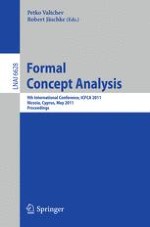This book constitutes the refereed proceedings of the 9th International Conference on Formal Concept Analysis, ICFCA 2011, held in Nicosia, Cyprus, in May 2011.
The 16 revised full papers presented together with 3 invited talks were carefully reviewed and selected from 49 submissions. The central theme was the mathematical formalization of concept and conceptual hierarchy. The field has developed into a constantly growing research area in its own right with a thriving theoretical community and an increasing number of applications in data and knowledge processing including disciplines such as data visualization, information retrieval, machine learning, software engineering, data analysis, data mining, social networks analysis, etc.
